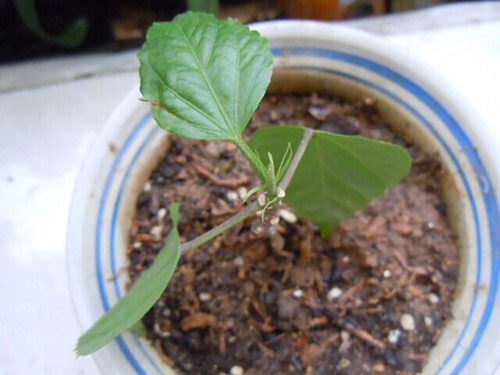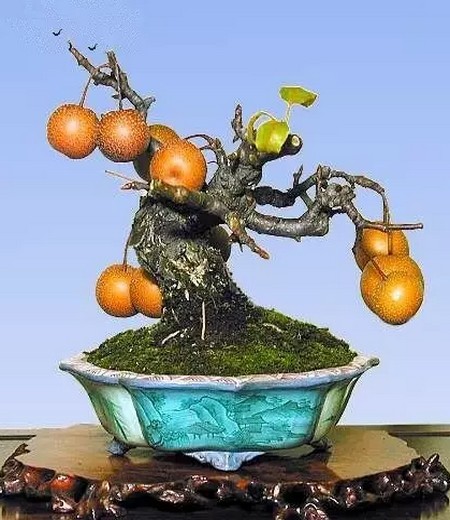Pruning method of pear bonsai
Pear trees are suitable for making many different forms of bonsai, such as direct dry type, oblique dry type, curved dry type, double dry type, jungle type, facing water type, horizontal dry type and so on. Because of the large leaves, the crown is mostly in the natural shape, and does not have to be tied into a sheet. Due to the strong growth of pear trees, large annual growth and vigorous development of top techniques, bonsai of any form should be used to control the growth of strong branches to form a short, compact, natural and beautiful crown, and promote the transformation from vegetative growth to reproductive growth, which is conducive to the formation of flower buds.
The pear tree has a large fruit, which is the main viewing point of its bonsai. When cultivating the crown, the size, number and distribution of the fruit should be determined according to the plant shape and nutrient reserve. And through drawing, twisting, bending, cutting and other methods, adjust the branch direction, increase the number of backbone branches, control strong branches, promote the growth of short branches, in order to cultivate robust fruiting branches, so that bonsai branches and leaves plump, the fruit is appropriate. The root system of pear tree is well developed, which can be raised according to the need to increase the artistic conception of the vicissitudes of bonsai.
After the tree shape is basically stable, attention should be paid to maintaining the vigorous growth of the tree potential to make it bear fruit year after year, combined with pruning and shaping, cutting off overgrown branches, cross branches, overlapping branches and dead branches, cutting short strong and strong branches, and promoting the sprouting of the lower part to develop into branches. to cultivate compact fruiting branches. And make the bonsai clear, dense and elegant, so as to achieve a natural and beautiful artistic effect.
Pear branches are divided into fruiting branches and vegetative branches. Fruit branches are divided into long fruit branches, medium fruit branches and short fruit branches. Pear bonsai should cultivate short fruit branches and short fruit branches composed of short fruit branches. In order to maintain the stump shape, it is necessary to prune the middle fruit branches. Vegetative branches are also divided into growing branches, growing branches and mediocre branches. According to the modeling needs, cut short the above branches and cut off the overgrown branches that disturb the tree shape, the over-dense mediocre branches and the budding shoots on the rootstock. The unformed young trees should cut short the branches according to the modeling needs, promote the branches and quickly form the basic skeleton, and then cultivate the ideal robust fruiting branches group year by year, so as to form a tree with a short crown but a lot of fruit.
For the formed pear bonsai, the vegetative growth and reproductive growth should be balanced and regulated according to the variety characteristics and growth potential. When blooming and bearing too much, it is necessary to thinning flowers and fruits properly, so as to control reproductive growth and promote vegetative growth. After the pear tree shows its buds, it is necessary to remove the buds that are too small, deformed and improperly planted. Fruit thinning should be carried out in batches, and the first fruit thinning should be carried out about half a month after flowering, removing overdense, diseased, deformed and leafless fruits from inflorescences, leaving 2 or 3 young fruits in each inflorescence. The second time is "fixed fruit", which is usually carried out after normal physiological fruit drop from late May to early June. One or two fruits can be selected for each fruit platform according to the size of the fruit. If the tree is strong, it can stay more, and if it is weak, it will stay less.
Time: 2019-06-11 Click:
- Prev

The Cuttage Propagation technique of Mulberry Flower
Fusang flowers are deeply loved by everyone. If there are some walls in the house, or even a corner that is not very beautiful, you can plant a mulberry flower. He is growing so fast that he can make up the corner right away. And his roots won't hurt the wall base. But you can't plant it too close to the window, because he's growing fast.
- Next

Watering skills of pear bonsai
Pear trees need sufficient water supply in the whole growing period, and the leaves of pear trees are very sensitive to water, wilting if there is a little loss of water, and scorching and shedding after a little longer time. In the growing season, such as early flowering, late flowering and fruit speed for a long time, such as insufficient water supply
Related
- Fuxing push coffee new agricultural production and marketing class: lack of small-scale processing plants
- Jujube rice field leisure farm deep ploughing Yilan for five years to create a space for organic food and play
- Nongyu Farm-A trial of organic papaya for brave women with advanced technology
- Four points for attention in the prevention and control of diseases and insect pests of edible fungi
- How to add nutrient solution to Edible Fungi
- Is there any good way to control edible fungus mites?
- Open Inoculation Technology of Edible Fungi
- Is there any clever way to use fertilizer for edible fungus in winter?
- What agents are used to kill the pathogens of edible fungi in the mushroom shed?
- Rapid drying of Edible Fungi

